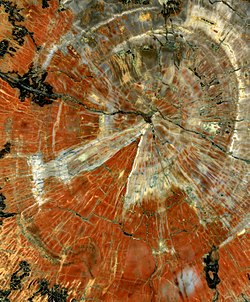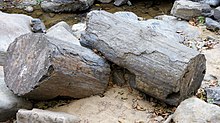Polished slice of a petrified tree from the Late Triassic Epoch (approximately 230 million years ago) found in Arizona. The remains of insects can be detected in an enlarged image.
Petrified log at the Petrified Forest National Park
Petrified wood (from the Latin root petro meaning "rock" or "stone"; literally "wood turned into stone") is the name given to a special type of fossilized remains of terrestrial vegetation. Petrifaction is the result of a tree or tree-like plants having been replaced by stone via a mineralization process that often includes permineralization and replacement. The organic materials making up cell walls have been replicated with minerals (mostly a silicate, such as opal, chalcedony, or quartz).
In some instances, the original structure of the stem tissue may be
partially retained. Unlike other plant fossils, which are typically
impressions or compressions, petrified wood is a three-dimensional
representation of the original organic material.
The petrifaction process occurs underground, when wood becomes buried in water-saturated sediment or volcanic ash. The presence of water reduces the availability of oxygen
which inhibits aerobic decomposition by bacteria and fungi.
Mineral-laden water flowing through the sediments may lead to
permineralization, which occurs when minerals precipitate out of
solution filling the interiors of cells and other empty spaces. During
replacement, the plant's cell walls act as a template for mineralization. There needs to be a balance between the decay of cellulose and lignin and mineral templating for cellular detail to be preserved with fidelity. Most of the organic matter often decomposes, however some of the lignin may remain. Silica in the form of Opal-A, can encrust and permeate wood relatively quickly in hot spring environments.
However, petrified wood is most commonly associated with trees that
were buried in fine grained sediments of deltas and floodplains or
volcanic lahars and ash beds. A forest where such material has petrified becomes known as a petrified forest.
Elements
The outline of cells visible in a segment of petrified wood
Elements such as manganese, iron, and copper in the water/mud during the petrification process give petrified wood a variety of color ranges. Pure quartz crystals are colorless, but when contaminants are added to the process the crystals take on a yellow, red, or another tint.
Following is a list of contaminating elements and related color hues:
- carbon – black
- chromium – green/blue
- cobalt – green/blue
- copper – green/blue
- iron oxides – red, brown, and yellow
- manganese – pink/orange
- manganese oxides – blackish/yellow
- silicon dioxide – clear/white/grey
Petrified wood can preserve the original structure of the stem in all
its detail, down to the microscopic level. Structures such as tree rings and the various tissues are often observed features.
Petrified wood is a fossil in which the organic remains have been
replaced by minerals in the slow process of being replaced with stone.
This petrification process generally results in a quartz chalcedony
mineralization. Special rare conditions must be met in order for the
fallen stem to be transformed into fossil wood or petrified wood. In
general, the fallen plants get buried in an environment free of oxygen
(anaerobic environment), which preserves the original plant structure
and general appearance. The other conditions include regular access to
mineral-rich water in contact with the tissues, replacing the organic
plant structure with inorganic minerals. The end result is petrified
wood, a plant, with its original basic structure in place, replaced by
stone.
Uses
Following the Great Depression
in the 1930s, people began flocking to the mountains and deserts hoping
to discover any sort of rock, stone or gem that could be turned into
jewelry as a source of income. An assortment of rock was discovered
which included petrified woods. "Rockhounding", as hobbyists would call
it, became very popular. Many rock clubs began to establish throughout
the United States. Soon after collectors
started setting up rock shops where they were able to sell their
merchandise to the public. As years went by rockhounders would perfect
their craft at making jewelry
using all sorts of different techniques, equipment, and molds. Having
experience with their craft, first-generation rockhounders would soon
teach fellow amateurs their skills.
Locations
Areas with a large number of petrified trees include:
Africa
Chunk of petrified wood near El Kurru (Northern Sudan)
- Egypt – petrified forest in Cairo-Suez road, declared a national protectorate by the ministry of environment, also in the area of New Cairo at the Extension of Nasr City, El Qattamiyya, near El Maadi district, and Al Farafra oasis.
- Libya – Great Sand Sea – Hundreds of square miles of petrified trunks, branches and other debris mixed with Stone Age artifacts
- Madagascar – Northwest Coast
- Namibia – petrified forest of Damaraland
- Sudan – petrified forest north of El-Kurru
Asia
- China – in the Junggar Basin of Xinjiang, northwest China government has issued a crackdown on collecting of this material.
- India – protected geological sites known for petrified wood are the National Fossil Wood Park, Tiruvakkarai (20-million-year-old fossils) and the Akal Wood Fossil Park (180-million-year-old fossils). Petrified wood has also been discovered in Dholavira in Kutch, Gujarat, dating back to 187–176 million years.
- Indonesia – petrified wood covers several area in Banten and also in some part of Mount Halimun Salak National Park.
- Israel – several examples of petrified wood occur in the HaMakhtesh HaGadol in the Negev desert.
- Pakistan - Sindh - Dadu - Petrified Forest at Khirthar National Park
- Saudi Arabia – petrified forest north of Riyadh
- Thailand – Bantak Petrified Forest Park in Ban Tak District
Australasia
- Australia – has deposits of petrified and opalised wood. Chinchilla, Queensland is famous for its 'Chinchilla Red'.
- New Zealand:
- Curio Bay on the Catlins coast contains many petrified wood examples.
- Fossil Forest, Takapuna, Auckland, New Zealand
Europe
- Belgium – Geosite Goudberg near Hoegaarden.
- Czech Republic, Nová Paka – The most famous locality on Permian–Carboniferous rocks in the Czech Republic.
- France – petrified forest in the village of Champclauson
- Georgia – Goderdzi Petrified Forest Natural Monument.
- Germany – the museum of natural history in Chemnitz has a collection of petrified trees, from the in situ Chemnitz petrified forest, found in the town since 1737.
- Greece – Petrified forest of Lesvos, at the western tip of the island of Lesbos, is possibly the largest of the petrified forests, covering an area of over 150 km2 (58 sq mi) and declared a National Monument in 1985. Large, upright trunks complete with root systems can be found, as well as trunks up to 22 m in length.
- Italy:
- Foresta fossile di Dunarobba, petrified forest near Avigliano Umbro, Umbria (Central Italy), age Piacenzian.
- Foresta pietrificata di Zuri – Soddì, petrified forest near Soddì (Province of Oristano, Sardinia), age Chattian–Aquitanian.
- Ukraine – petrified araucaria trunks near Druzhkivka
- United Kingdom – many examples of petrified submerged forests can be found at low tide around the coast of England and Wales.
- Fossil Grove, Glasgow, Scotland
- Fossil Forest, Dorset, England
North America
Petrified logs at Petrified Forest National Park, Arizona, USA
- Canada – in the badlands of southern Alberta; petrified wood is the provincial stone of Alberta. Axel Heiberg Island in Nunavut has a large petrified forest. In and around the North Saskatchewan river, around the Edmonton area. Blanche Brook, in Stephenville, Newfoundland, has 305-million-year-old examples.
- United States – petrified wood sites include:
- Petrified Wood Park in Lemmon, South Dakota
- Ginkgo/Wanapum State Park in Washington state
- Petrified Forest National Park in Arizona
- Petrified Forest in California
- Mississippi Petrified Forest in Flora, Mississippi
- Florissant Fossil Beds National Monument near Florissant, Colorado
- Yellowstone Petrified Forest and Gallatin Petrified Forest, Yellowstone National Park, Wyoming
- The south unit of Theodore Roosevelt National Park outside Medora, North Dakota
- Gilboa Fossil Forest, New York
- Escalante Petrified Forest State Park in Utah
- Agate Desert in the Upper Rogue River Valley near Medford, Oregon
- Fossil Forest in the Catskill region near Cairo, New York
- Valley of Fire State Park in Nevada
South America
Petrified log in Paleorrota geopark, Brazil
Puyango petrified forest, Ecuador
- Argentina – the Sarmiento Petrified Forest and Jaramillo Petrified Forest in Santa Cruz Province in the Argentine Patagonia have many trees that measure more than 3 m (9.8 ft) in diameter and 30 m (98 ft) long.
- Brazil:
- in the geopark of Paleorrota, there is a vast area with petrified trees.
- In the Heritage forest
- Monumento Natural das Árvores Fossilizadas (Fossil Trees Natural Monument) in Tocantins: petrified forests of dicksoniaceae (specifically Psaronius and Tietea singularis) and arthropitys
- Petrified forests of dicksoniaceae (specifically Psaronius and Tietea singularis) and arthropitys can also be found in the state of São Paulo
- Floresta Fóssil de Teresina near Rio Poti, Piauí, Permian (around 280–270 million years ago).
- Ecuador – Puyango Petrified Forest – One of the largest collections of petrified wood in the world.
Gallery
- Petrified Acacia wood












